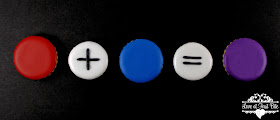Last time, I took you back to your childhood days of color theory and we learned about the primary colors. It is always fun reliving the days of our youth...don't you agree? Just to refresh your memory, let's pick up where we left off.
When red and yellow mix together it makes orange.
When yellow and blue mix together it makes green.
When red and blue mix together it makes violet.
This new set of colors produced by mixing two primary colors together (in equal parts) are known as secondary colors.
Orange, green and violet (violet is also referred to as the color purple) are triadic colors (think triangle again). They are equally spaced on the color wheel and are opposite of the primary colors (red, yellow and blue).
In theory, these secondary colors (orange, green and violet) should be clear and bright when they are mixed, but most of the time they come out looking muddy. Have you ever mixed red and blue food coloring to your icing and wondered why the violet (purple) comes out looking flat and gray...not the vibrant color like you envisioned?
There is a reason why we don't always achieve the right colors when we mix primary colors together. What I am about to tell you...just might blow your mind.
True primary colors don't actually exist.
Primary colors are either imaginary sensations that you can't see (colors that lie outside the range of visual colors) or they are imperfect (not pure in color) because it is not possible for them to mix all the colors...therefore they aren't really "primary".
Food colors are actually a mix of one or more color dyes and each brand uses different formulas to create their colors. So, not all color is created equal. The result of mixing primary colors depends entirely on how the pigments or dyes work together. I will be discussing the differences of each brand of food coloring later on and you won't want to miss it...trust me.
Let's move onto the remaining set of six colors that make up the color wheel.
When red and orange mix together it makes red-orange.
When yellow and orange mix together it makes yellow-orange.
When yellow and green mix together it makes yellow-green.
When blue and green mix together it makes blue-green.
When blue and violet mix together it makes blue-violet.
When red and violet mix together it makes red-violet.
Have a wonderful and colorful week:-)




















